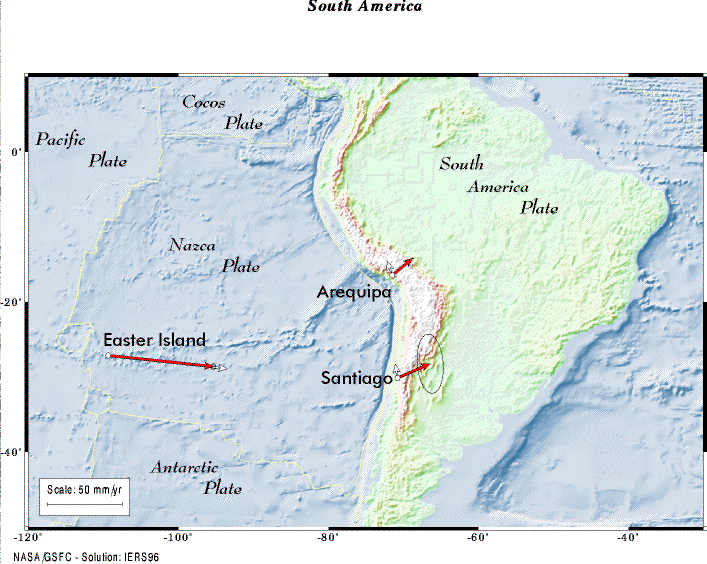
The horizontal components of tectonic motion that have been estimated from the GSFC analysis of SLR data are plotted as white vectors on this map. The blue vectors represent the motions for the sites as given by the NUVEL-1A geologically determined plate motion model. The frame within which these motions are placed is defined mathematically such that, in an integrated sense, there is no uniform net rotation remaining (called a "no net rotation" frame, or NNR frame). One should keep in mind that this is a mathematical idealization and that these motions only approximate the velocity relative to a fixed mantle.
There are 3 SLR stations plotted on this map. They each are in interesting regions of the world. Beginning with the site at Easter Island, which resides on one of the fastest moving plates, the Nazca plate, the SLR estimate of motion is generally slower t han that expected from the NNR-NUVEL1A model. An explanation for this may be related to a possibility that there is a very gradual slowing of the some of the plate velocities over time. The NUVEL-1A model of plate motion is based on geological evidence, p articularly, the "speed" of the plates is derived from studying the patterns of a specific magnetic anomaly on the ocean floors. The anomaly used in the development of NUVEL-1A is approximately 3 million years old, thus the rates implied by this anomaly a re averaged over this time span of 3 million years. On the other hand, the SLR data used to estimate site motions only spans about 15 years. If there is any slow-down (or speed-up) between these time spans, then one might expe! ct to observe this in these results. There has been uncovered some evidence of a small amount of slowing of the rate of the Pacific/Nazca boundary (along which are the fastest relative plate rates in the world) over the last 3 million years. This would pr ovide one possible explanation for the slower SLR velocity at Easter Island.
The two sites in South America, Arequipa and Santiago, are located in the deforming collision boundary zone between the Nazca plate and the South America plate. The Nazca plate subducts beneath South America and, like the case at Simosato (see the Pacific Map), a portion of the subduction motion is being transferred into a portion of the over-riding plate. This explains why the motions for these two sites appear deflected to the east, relative to their modeled South America NN R-NUVEL1A motion.
Responsible NASA Official: Ben Chao
Original Web Implementation: John W. Robbins